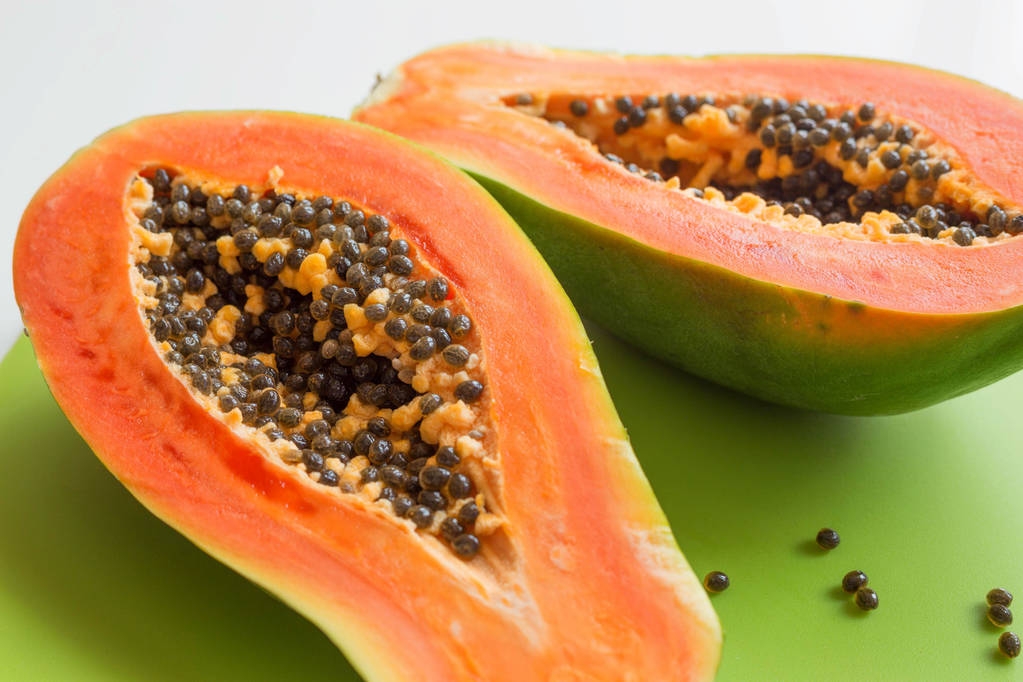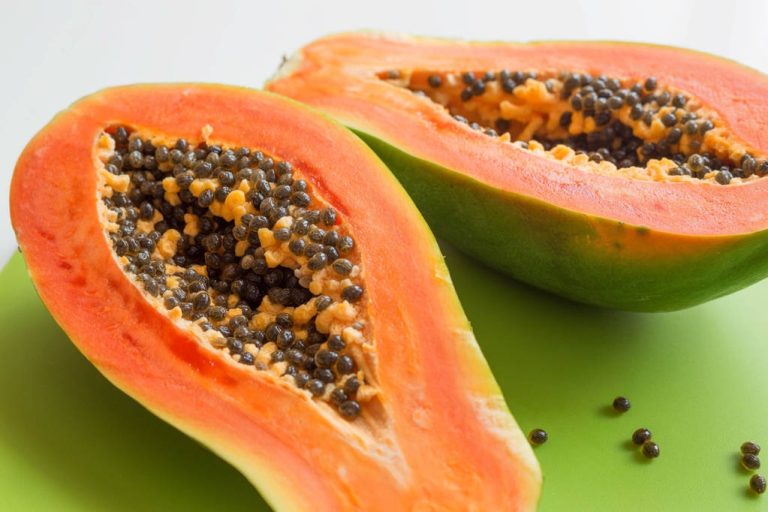The papaya has long since conquered its fixed place on the domestic fruit shelves. The fruit, which weighs about one pound and is also known as “tree melon”, can be found there all year round.
Its juice, leaves, pulp and even the seeds are said to have numerous health benefits. Papaya is said to help you lose weight, relieve gastrointestinal problems, strengthen the immune system, serve as a natural contraceptive, supposedly even cure cancer and much more. Scientific studies should also prove these effects, which the Indians have been using for centuries.
At first glance, it sounds so great that there must be at least one catch. We went on a search and looked at the super fruit papaya from all sides.
Papaya tree, papaya bush or something else?
The papaya, scientific name Carica papaya, belongs to the melon tree family. However, the papaya tree, which is 3 to 10 meters high, is not a real tree, but a very special plant species. Although tree-like in appearance, the trunk is not woody and is therefore not considered a tree or shrub in the botanical sense, but is classified as a herb. That alone makes the tree melon, which grows in tropical and subtropical regions around the world, something special.
The fruits of the papaya tree are therefore berries, which can be very different in size and weight depending on the variety. The Hawaiian papaya variety “Solo” that is mostly commercially available in this country weighs around 500 grams. Other varieties, for example in Mexico, reach a weight of 3 to 6 kilograms. The skin of a ripe fruit is yellow-green, the sweet, juicy flesh is light orange to pink. The black kernels inside are the seeds of the papaya tree, which are edible and taste slightly peppery.
Vitamins, Minerals and Calories of Papaya
Of course, papaya not only contains the enzymes, but also many other valuable nutrients. The pulp, for example, is a real vitamin C bomb, just 100 grams almost cover the daily requirement of an adult. The tree melon also contains vitamins A, E, B1 to B6 and folic acid.
The fruit provides minerals in particular potassium, calcium and magnesium, but also manganese, iron, copper and zinc. But it is economical with calories: Only 32 kcal per 100 g make the tropical fruit very suitable for dieting. And the other nutritional values of the papaya are also impressive, as it mainly contains water and fiber, some fructose and no fat.
Eating a papaya properly
Papaya can be eaten raw as a healthy snack between meals. To do this, halve the ripe fruit, recognizable by the yellow skin and the soft flesh. Then remove the seeds and scoop the flesh straight out of the skin. Alternatively, you can also peel the fruit, separate the pulp and seeds and mix it into muesli or fruit salad.
The seeds are edible, but because of the pungent taste they are usually dried and then used. You should only ever eat the ripe melon raw, an unripe fruit tastes bitter and is hardly edible. The unripe melon contains a particularly large number of valuable enzymes.
Papaya Recipes: Smoothie, Salad and More
There are many papaya recipes, the name “tree melon” already gives it away: A ripe papaya fits anywhere a melon fits. A quick appetizer can be conjured up from the tropical fruit with raw ham or a carpaccio as a vegetarian variant. Peel an unripe papaya, cut it into pieces and cook it in a stew with meat or poultry. Fans of Thai cuisine will love the fruity-spicy papaya salad in all variations – quickly prepared, it brings variety to everyday kitchen life. Processed with bananas, oranges and other fruits into an exotic smoothie, the tree melon is the ideal source of vitamin C for gray winter days.
Small cores with a big effect
Seeds are said to be the most effective ingredient in tree melon. They are usually not eaten with the fresh fruit, but as cleaned and dried grains. Because of their similarity to peppercorns and their slightly peppery note, papaya seeds used to be used to dilute expensive pepper. Today, the seeds, which are not really cheap at around 30 euros per kilo, are chewed pure or ground over food, as in the countries of origin. The kernels act as a tenderizer, especially with meat, which is why concentrates from them are still used in industry today.
The papaya kernels are now used not only in the regions of origin, but also in Europe for various “medicinal” purposes. The grains serve as a natural anthelmintic (anti-wormer) for humans or pets. In addition, the consumption of a tablespoon of seeds daily makes men temporarily unable to conceive after about three months – it is said. This makes the seeds a practical, natural contraceptive.
The seeds also help with gastrointestinal complaints, for example after a sumptuous meal. Chewing a tablespoon of it supports digestion and relieves the stomach and intestines.
The secret of the papaya: enzymes as the active ingredient
The papaya enzymes, especially papain, are responsible for the positive health effects of the fruit. The pulp and seeds also contain chymopapain A and B, and the leaves also contain saponins, alkaloids and glucosinolates. Papain is very similar to pepsin, one of the most important enzymes in the stomach. Papain is able to break down proteins, which explains its support for digestion and its effect as a meat tenderizer.
There are numerous studies and investigations on the medical effects of papaya enzymes, ranging from contraceptives to wound healing to the treatment of cancer. For example, a study published in the Pakistan Journal of Biological Sciences in 2010 found papain to improve wound healing, suggesting an effect in conditions such as psoriasis. And this papaya enzyme also seems to be a promising treatment option for the consequences of type II diabetes.
When it comes to cancer therapy, the tree melon can also score points. In test series, their enzymes showed a tumor-reducing or even tumor-dissolving effect. And even with dengue fever, a widespread tropical disease, the enzymes in the papaya improve or even cure it.
Does papaya really heal almost everything?
The positive effect of papaya for humans is far from proven; more than 600 scientific studies only provide strong evidence. Most of this has been done either in test tubes, with cell cultures, or in animal experiments. A transfer of the effects to the human organism is therefore possible, but not guaranteed. Although the therapy against dengue fever has also been tested on humans, individual case studies and small samples are not meaningful enough for a proven effect. The same applies to the treatment of gastrointestinal complaints. Although an improvement was found in the people treated, the samples were far too small for general statements. Nevertheless, the papaya remains a hopeful starting point for future therapies.
Side effects of papaya
Of course, what is effective also has side effects. Papaya in its natural form (seeds, pulp or leaf extract) is considered relatively safe. However, the tree melon contains the so-called papaya latex, which can trigger cross-reactions with latex allergies. People with this allergy should therefore avoid papaya and all its components.
The same applies to pregnant women and people with a tendency to bleed or those who take blood thinners. The ingredients of the fruit can cause uncontrolled bleeding, primitive people used high doses as an abortifacient. In high doses (possible, for example, when eating papaya capsules), papain can lead to hypoglycaemia. Likewise, some people are allergic to papain or other enzymes found in tree melon.

